Supply Chain Management Information System Analysis Report
VerifiedAdded on 2023/05/28
|13
|3188
|365
Report
AI Summary
This report provides a comprehensive analysis of supply chain management information systems, focusing on the practices of Wal-Mart. The report begins with an introduction to supply chain management and its significance in business, highlighting the role of information systems in enhancing efficiency and reducing costs. It then delves into the theoretical foundations of supply chain management, exploring key theories such as agency theory, network theory, and resource-based view. A detailed examination of Wal-Mart's supply chain management practices follows, emphasizing the company's adoption of an integrated information system and its impact on procurement, distribution, logistics, and inventory management. The report also discusses the strengths and weaknesses of Wal-Mart's supply chain management, including its ability to reduce costs, create a strong supplier network, and improve communication. Finally, it concludes with recommendations based on the analysis of Wal-Mart's supply chain information system and its effectiveness.
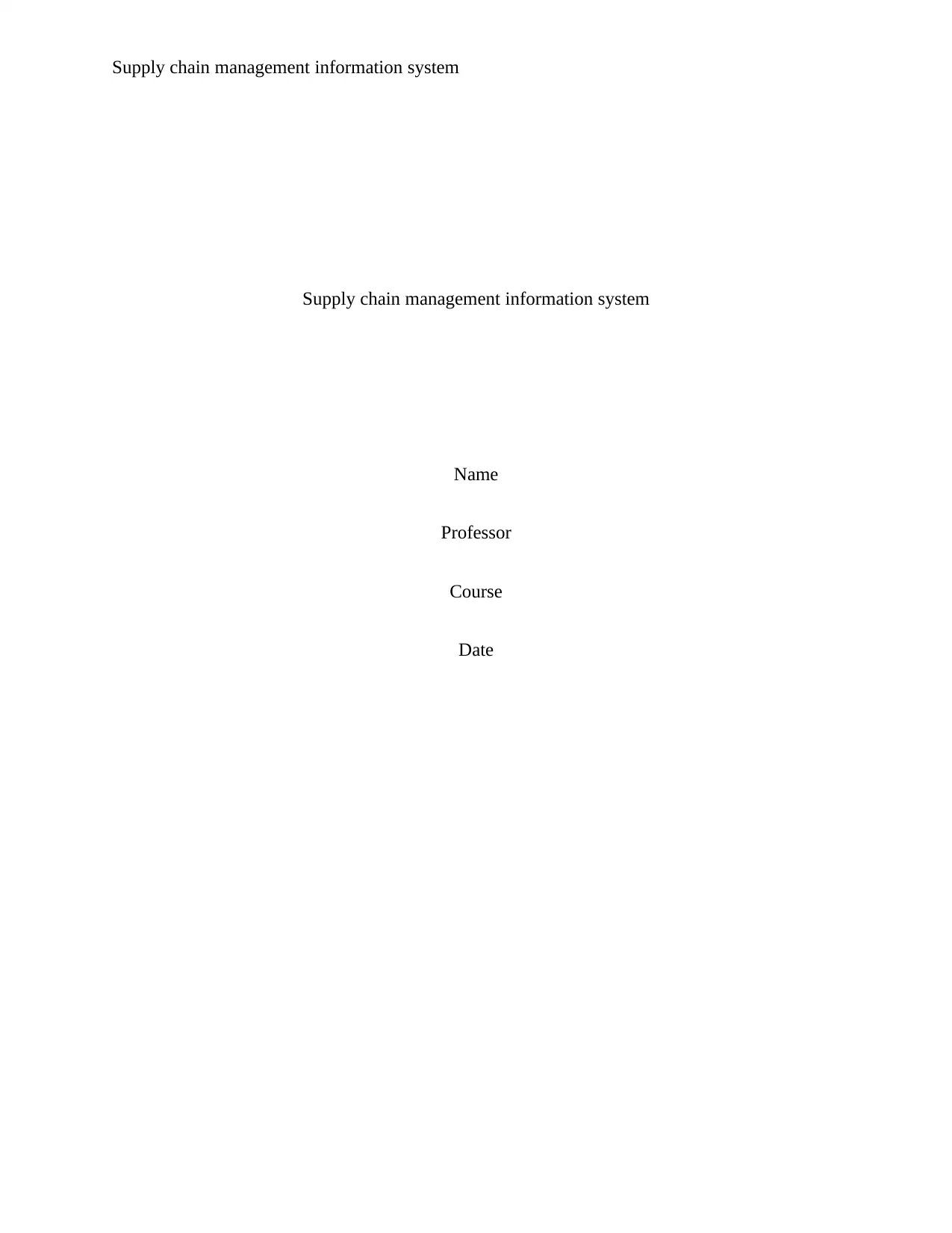
Supply chain management information system
Supply chain management information system
Name
Professor
Course
Date
Supply chain management information system
Name
Professor
Course
Date
Paraphrase This Document
Need a fresh take? Get an instant paraphrase of this document with our AI Paraphraser
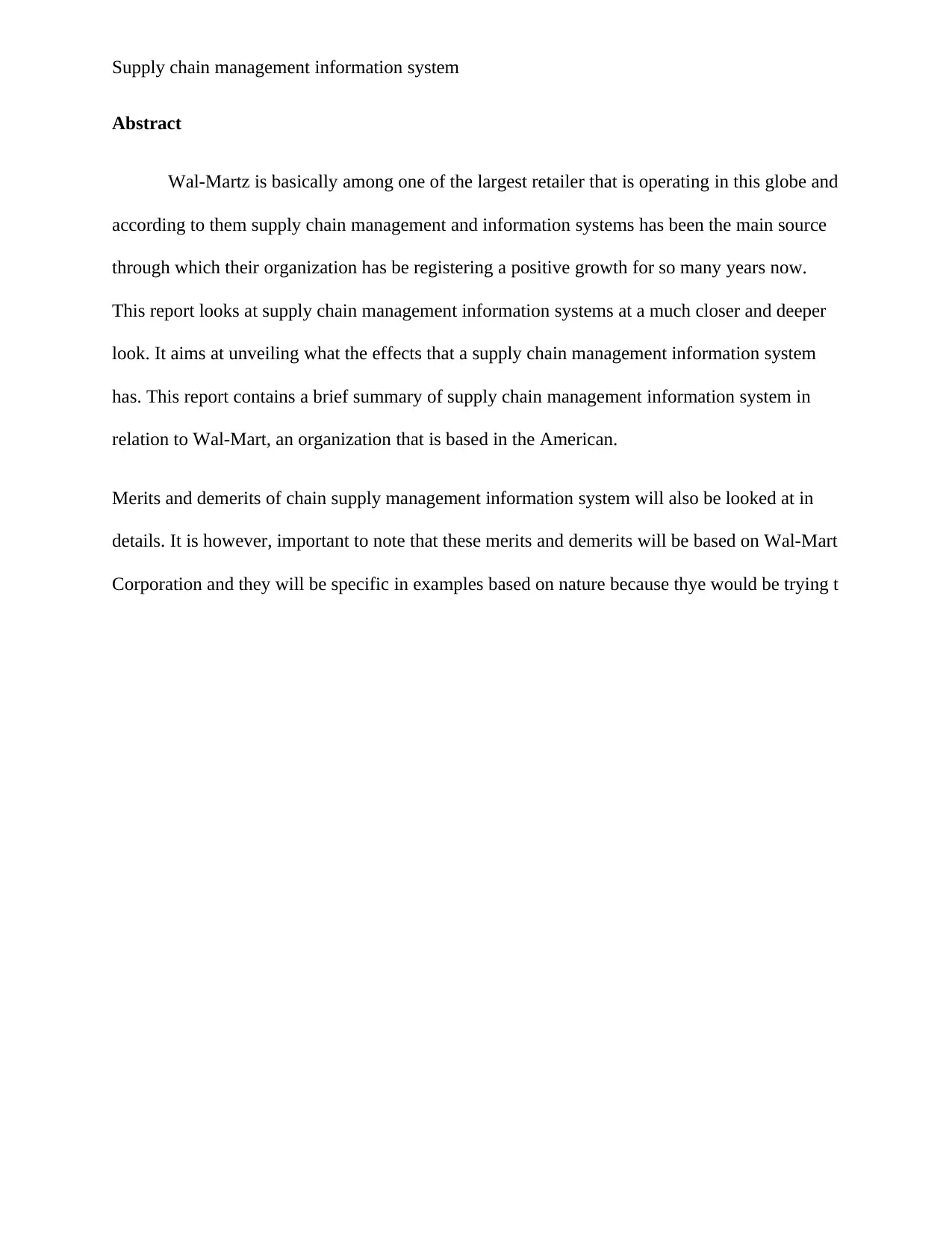
Supply chain management information system
Abstract
Wal-Martz is basically among one of the largest retailer that is operating in this globe and
according to them supply chain management and information systems has been the main source
through which their organization has be registering a positive growth for so many years now.
This report looks at supply chain management information systems at a much closer and deeper
look. It aims at unveiling what the effects that a supply chain management information system
has. This report contains a brief summary of supply chain management information system in
relation to Wal-Mart, an organization that is based in the American.
Merits and demerits of chain supply management information system will also be looked at in
details. It is however, important to note that these merits and demerits will be based on Wal-Mart
Corporation and they will be specific in examples based on nature because thye would be trying t
Abstract
Wal-Martz is basically among one of the largest retailer that is operating in this globe and
according to them supply chain management and information systems has been the main source
through which their organization has be registering a positive growth for so many years now.
This report looks at supply chain management information systems at a much closer and deeper
look. It aims at unveiling what the effects that a supply chain management information system
has. This report contains a brief summary of supply chain management information system in
relation to Wal-Mart, an organization that is based in the American.
Merits and demerits of chain supply management information system will also be looked at in
details. It is however, important to note that these merits and demerits will be based on Wal-Mart
Corporation and they will be specific in examples based on nature because thye would be trying t
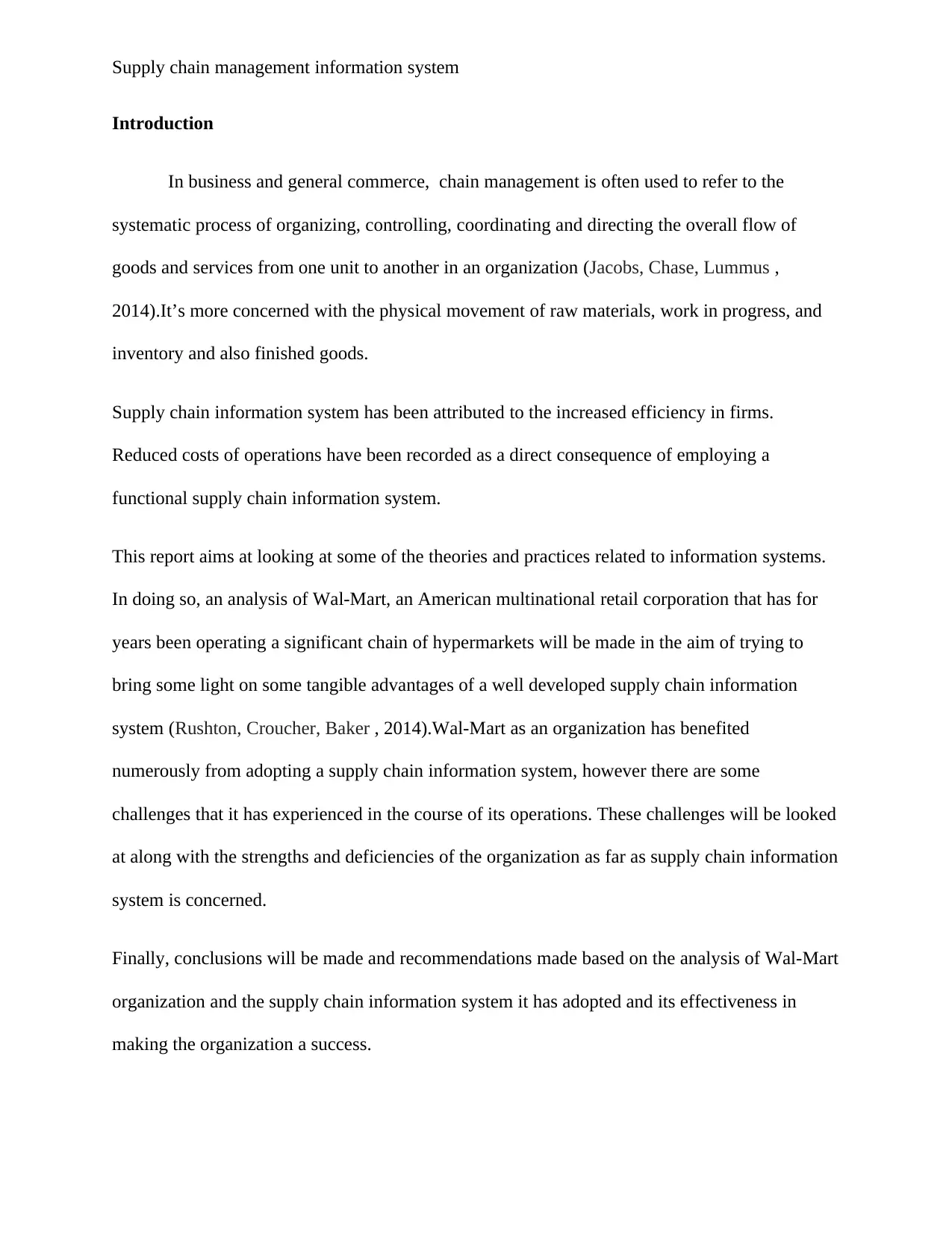
Supply chain management information system
Introduction
In business and general commerce, chain management is often used to refer to the
systematic process of organizing, controlling, coordinating and directing the overall flow of
goods and services from one unit to another in an organization (Jacobs, Chase, Lummus ,
2014).It’s more concerned with the physical movement of raw materials, work in progress, and
inventory and also finished goods.
Supply chain information system has been attributed to the increased efficiency in firms.
Reduced costs of operations have been recorded as a direct consequence of employing a
functional supply chain information system.
This report aims at looking at some of the theories and practices related to information systems.
In doing so, an analysis of Wal-Mart, an American multinational retail corporation that has for
years been operating a significant chain of hypermarkets will be made in the aim of trying to
bring some light on some tangible advantages of a well developed supply chain information
system (Rushton, Croucher, Baker , 2014).Wal-Mart as an organization has benefited
numerously from adopting a supply chain information system, however there are some
challenges that it has experienced in the course of its operations. These challenges will be looked
at along with the strengths and deficiencies of the organization as far as supply chain information
system is concerned.
Finally, conclusions will be made and recommendations made based on the analysis of Wal-Mart
organization and the supply chain information system it has adopted and its effectiveness in
making the organization a success.
Introduction
In business and general commerce, chain management is often used to refer to the
systematic process of organizing, controlling, coordinating and directing the overall flow of
goods and services from one unit to another in an organization (Jacobs, Chase, Lummus ,
2014).It’s more concerned with the physical movement of raw materials, work in progress, and
inventory and also finished goods.
Supply chain information system has been attributed to the increased efficiency in firms.
Reduced costs of operations have been recorded as a direct consequence of employing a
functional supply chain information system.
This report aims at looking at some of the theories and practices related to information systems.
In doing so, an analysis of Wal-Mart, an American multinational retail corporation that has for
years been operating a significant chain of hypermarkets will be made in the aim of trying to
bring some light on some tangible advantages of a well developed supply chain information
system (Rushton, Croucher, Baker , 2014).Wal-Mart as an organization has benefited
numerously from adopting a supply chain information system, however there are some
challenges that it has experienced in the course of its operations. These challenges will be looked
at along with the strengths and deficiencies of the organization as far as supply chain information
system is concerned.
Finally, conclusions will be made and recommendations made based on the analysis of Wal-Mart
organization and the supply chain information system it has adopted and its effectiveness in
making the organization a success.
You're viewing a preview
Unlock full access by subscribing today!
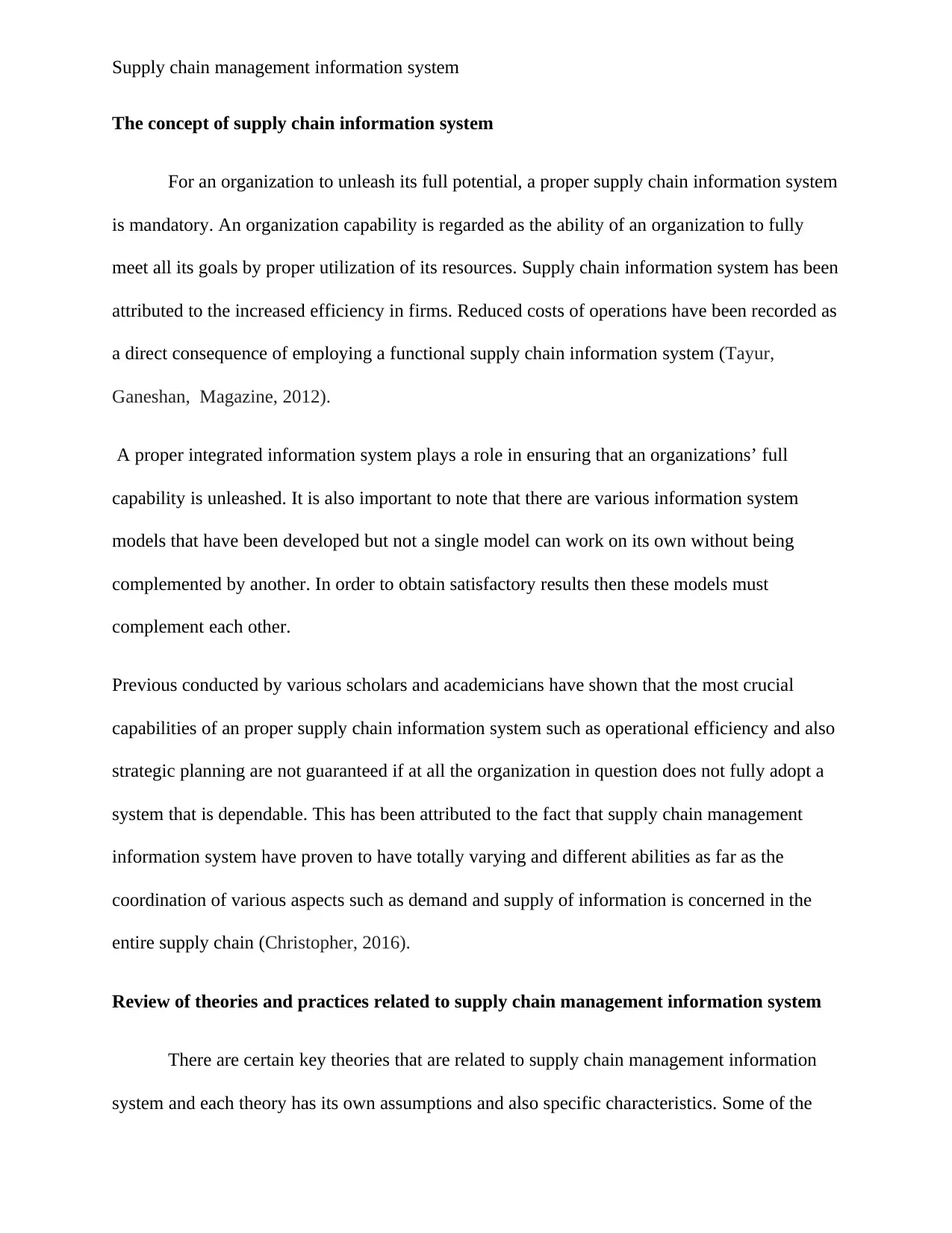
Supply chain management information system
The concept of supply chain information system
For an organization to unleash its full potential, a proper supply chain information system
is mandatory. An organization capability is regarded as the ability of an organization to fully
meet all its goals by proper utilization of its resources. Supply chain information system has been
attributed to the increased efficiency in firms. Reduced costs of operations have been recorded as
a direct consequence of employing a functional supply chain information system (Tayur,
Ganeshan, Magazine, 2012).
A proper integrated information system plays a role in ensuring that an organizations’ full
capability is unleashed. It is also important to note that there are various information system
models that have been developed but not a single model can work on its own without being
complemented by another. In order to obtain satisfactory results then these models must
complement each other.
Previous conducted by various scholars and academicians have shown that the most crucial
capabilities of an proper supply chain information system such as operational efficiency and also
strategic planning are not guaranteed if at all the organization in question does not fully adopt a
system that is dependable. This has been attributed to the fact that supply chain management
information system have proven to have totally varying and different abilities as far as the
coordination of various aspects such as demand and supply of information is concerned in the
entire supply chain (Christopher, 2016).
Review of theories and practices related to supply chain management information system
There are certain key theories that are related to supply chain management information
system and each theory has its own assumptions and also specific characteristics. Some of the
The concept of supply chain information system
For an organization to unleash its full potential, a proper supply chain information system
is mandatory. An organization capability is regarded as the ability of an organization to fully
meet all its goals by proper utilization of its resources. Supply chain information system has been
attributed to the increased efficiency in firms. Reduced costs of operations have been recorded as
a direct consequence of employing a functional supply chain information system (Tayur,
Ganeshan, Magazine, 2012).
A proper integrated information system plays a role in ensuring that an organizations’ full
capability is unleashed. It is also important to note that there are various information system
models that have been developed but not a single model can work on its own without being
complemented by another. In order to obtain satisfactory results then these models must
complement each other.
Previous conducted by various scholars and academicians have shown that the most crucial
capabilities of an proper supply chain information system such as operational efficiency and also
strategic planning are not guaranteed if at all the organization in question does not fully adopt a
system that is dependable. This has been attributed to the fact that supply chain management
information system have proven to have totally varying and different abilities as far as the
coordination of various aspects such as demand and supply of information is concerned in the
entire supply chain (Christopher, 2016).
Review of theories and practices related to supply chain management information system
There are certain key theories that are related to supply chain management information
system and each theory has its own assumptions and also specific characteristics. Some of the
Paraphrase This Document
Need a fresh take? Get an instant paraphrase of this document with our AI Paraphraser
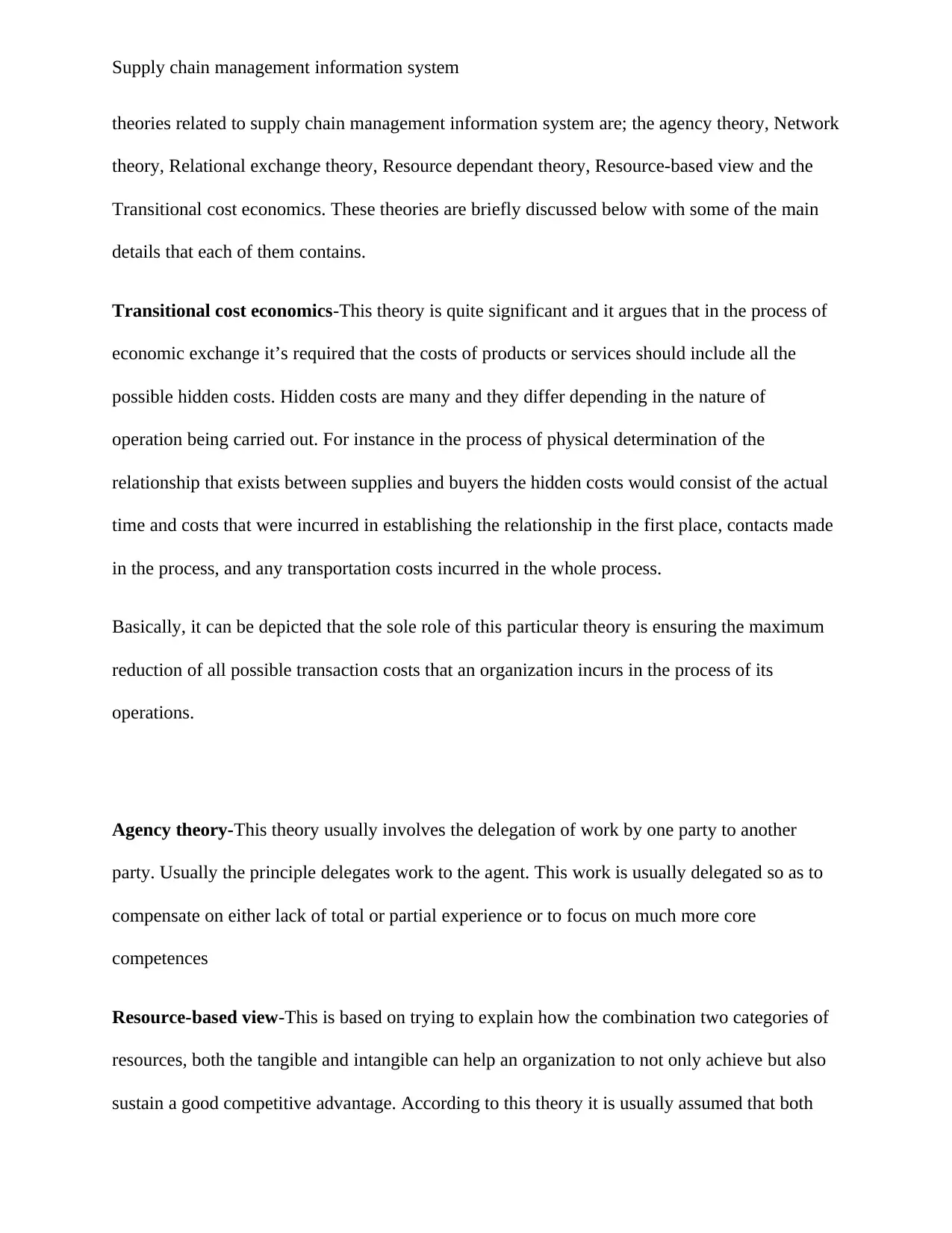
Supply chain management information system
theories related to supply chain management information system are; the agency theory, Network
theory, Relational exchange theory, Resource dependant theory, Resource-based view and the
Transitional cost economics. These theories are briefly discussed below with some of the main
details that each of them contains.
Transitional cost economics-This theory is quite significant and it argues that in the process of
economic exchange it’s required that the costs of products or services should include all the
possible hidden costs. Hidden costs are many and they differ depending in the nature of
operation being carried out. For instance in the process of physical determination of the
relationship that exists between supplies and buyers the hidden costs would consist of the actual
time and costs that were incurred in establishing the relationship in the first place, contacts made
in the process, and any transportation costs incurred in the whole process.
Basically, it can be depicted that the sole role of this particular theory is ensuring the maximum
reduction of all possible transaction costs that an organization incurs in the process of its
operations.
Agency theory-This theory usually involves the delegation of work by one party to another
party. Usually the principle delegates work to the agent. This work is usually delegated so as to
compensate on either lack of total or partial experience or to focus on much more core
competences
Resource-based view-This is based on trying to explain how the combination two categories of
resources, both the tangible and intangible can help an organization to not only achieve but also
sustain a good competitive advantage. According to this theory it is usually assumed that both
theories related to supply chain management information system are; the agency theory, Network
theory, Relational exchange theory, Resource dependant theory, Resource-based view and the
Transitional cost economics. These theories are briefly discussed below with some of the main
details that each of them contains.
Transitional cost economics-This theory is quite significant and it argues that in the process of
economic exchange it’s required that the costs of products or services should include all the
possible hidden costs. Hidden costs are many and they differ depending in the nature of
operation being carried out. For instance in the process of physical determination of the
relationship that exists between supplies and buyers the hidden costs would consist of the actual
time and costs that were incurred in establishing the relationship in the first place, contacts made
in the process, and any transportation costs incurred in the whole process.
Basically, it can be depicted that the sole role of this particular theory is ensuring the maximum
reduction of all possible transaction costs that an organization incurs in the process of its
operations.
Agency theory-This theory usually involves the delegation of work by one party to another
party. Usually the principle delegates work to the agent. This work is usually delegated so as to
compensate on either lack of total or partial experience or to focus on much more core
competences
Resource-based view-This is based on trying to explain how the combination two categories of
resources, both the tangible and intangible can help an organization to not only achieve but also
sustain a good competitive advantage. According to this theory it is usually assumed that both
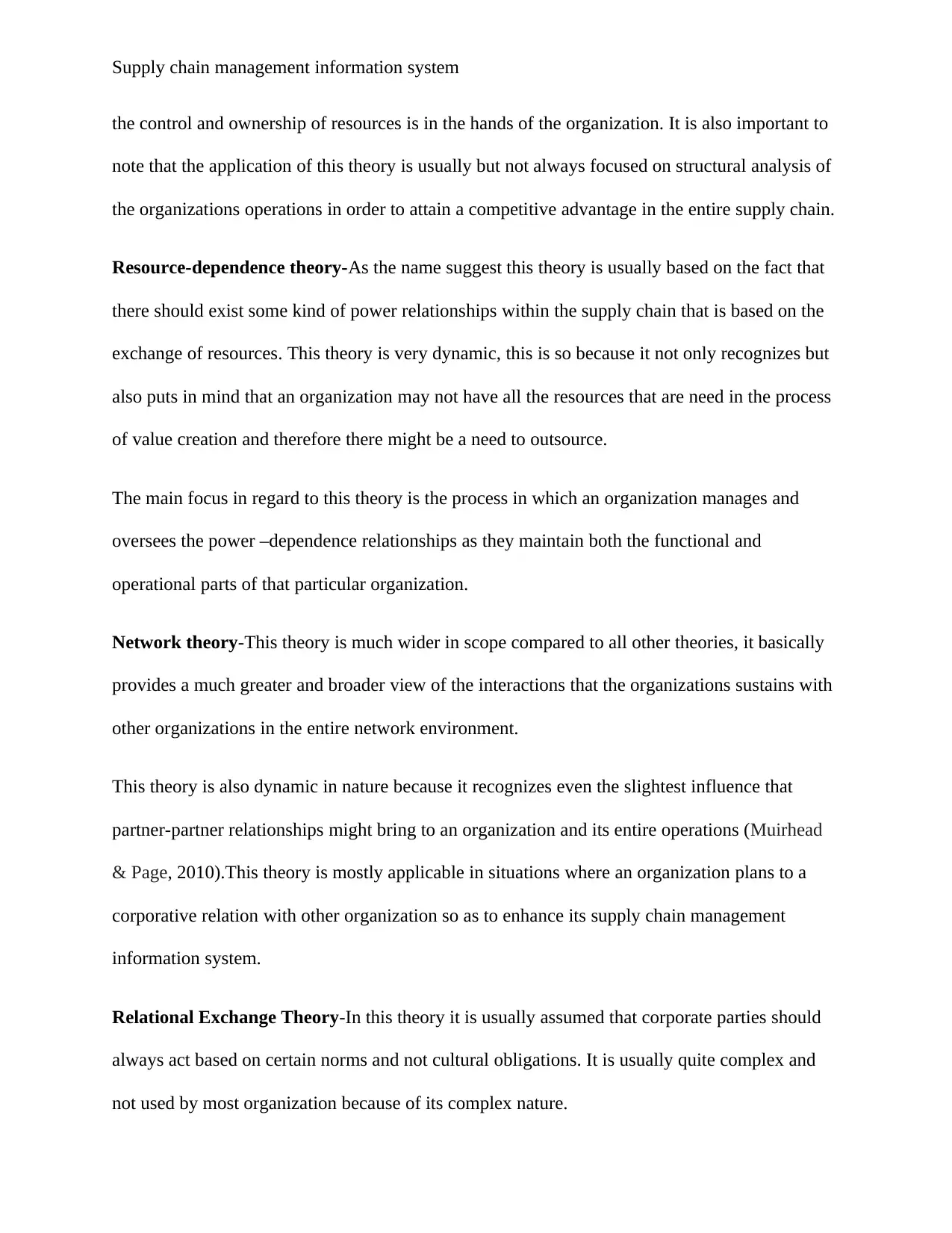
Supply chain management information system
the control and ownership of resources is in the hands of the organization. It is also important to
note that the application of this theory is usually but not always focused on structural analysis of
the organizations operations in order to attain a competitive advantage in the entire supply chain.
Resource-dependence theory-As the name suggest this theory is usually based on the fact that
there should exist some kind of power relationships within the supply chain that is based on the
exchange of resources. This theory is very dynamic, this is so because it not only recognizes but
also puts in mind that an organization may not have all the resources that are need in the process
of value creation and therefore there might be a need to outsource.
The main focus in regard to this theory is the process in which an organization manages and
oversees the power –dependence relationships as they maintain both the functional and
operational parts of that particular organization.
Network theory-This theory is much wider in scope compared to all other theories, it basically
provides a much greater and broader view of the interactions that the organizations sustains with
other organizations in the entire network environment.
This theory is also dynamic in nature because it recognizes even the slightest influence that
partner-partner relationships might bring to an organization and its entire operations (Muirhead
& Page, 2010).This theory is mostly applicable in situations where an organization plans to a
corporative relation with other organization so as to enhance its supply chain management
information system.
Relational Exchange Theory-In this theory it is usually assumed that corporate parties should
always act based on certain norms and not cultural obligations. It is usually quite complex and
not used by most organization because of its complex nature.
the control and ownership of resources is in the hands of the organization. It is also important to
note that the application of this theory is usually but not always focused on structural analysis of
the organizations operations in order to attain a competitive advantage in the entire supply chain.
Resource-dependence theory-As the name suggest this theory is usually based on the fact that
there should exist some kind of power relationships within the supply chain that is based on the
exchange of resources. This theory is very dynamic, this is so because it not only recognizes but
also puts in mind that an organization may not have all the resources that are need in the process
of value creation and therefore there might be a need to outsource.
The main focus in regard to this theory is the process in which an organization manages and
oversees the power –dependence relationships as they maintain both the functional and
operational parts of that particular organization.
Network theory-This theory is much wider in scope compared to all other theories, it basically
provides a much greater and broader view of the interactions that the organizations sustains with
other organizations in the entire network environment.
This theory is also dynamic in nature because it recognizes even the slightest influence that
partner-partner relationships might bring to an organization and its entire operations (Muirhead
& Page, 2010).This theory is mostly applicable in situations where an organization plans to a
corporative relation with other organization so as to enhance its supply chain management
information system.
Relational Exchange Theory-In this theory it is usually assumed that corporate parties should
always act based on certain norms and not cultural obligations. It is usually quite complex and
not used by most organization because of its complex nature.
You're viewing a preview
Unlock full access by subscribing today!
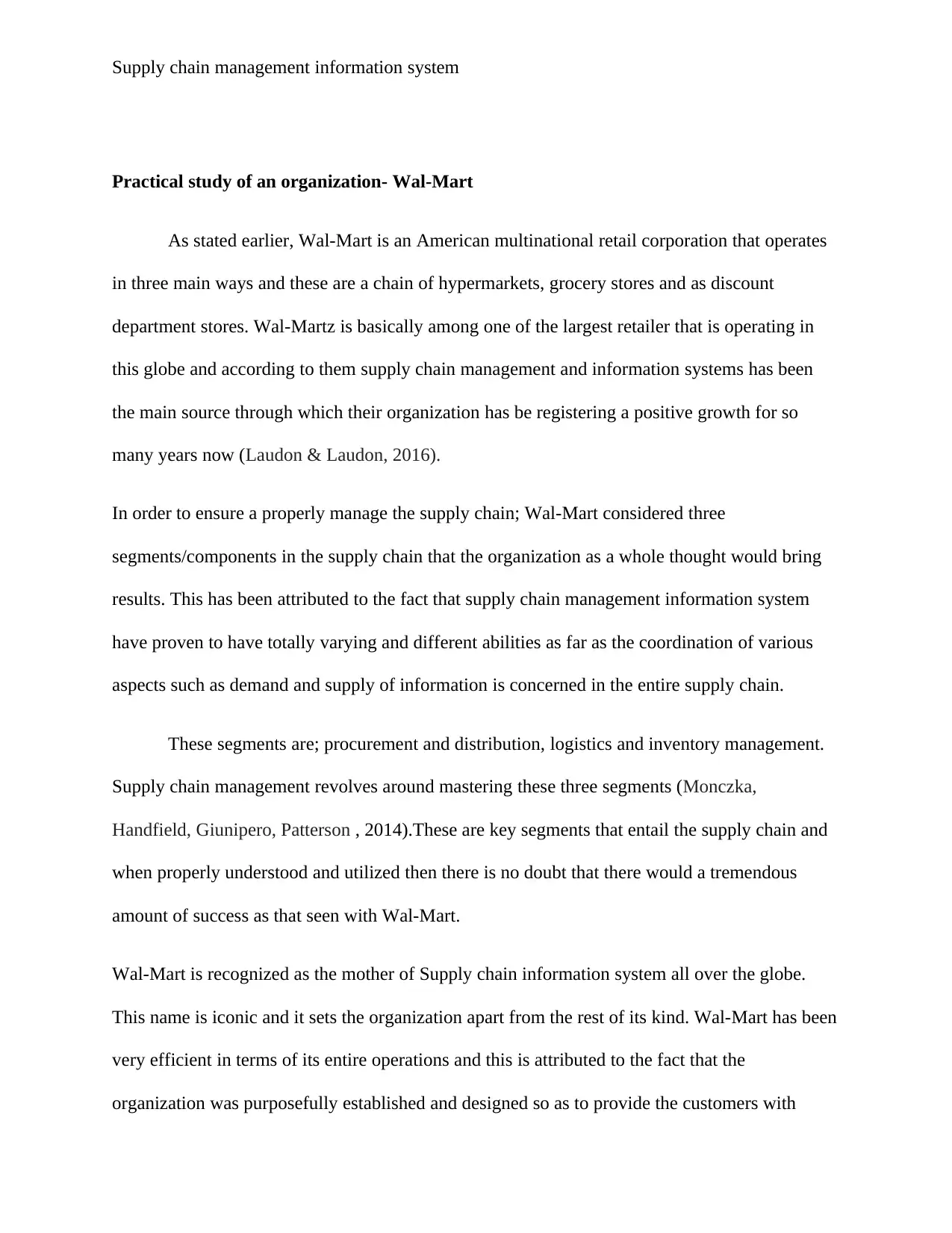
Supply chain management information system
Practical study of an organization- Wal-Mart
As stated earlier, Wal-Mart is an American multinational retail corporation that operates
in three main ways and these are a chain of hypermarkets, grocery stores and as discount
department stores. Wal-Martz is basically among one of the largest retailer that is operating in
this globe and according to them supply chain management and information systems has been
the main source through which their organization has be registering a positive growth for so
many years now (Laudon & Laudon, 2016).
In order to ensure a properly manage the supply chain; Wal-Mart considered three
segments/components in the supply chain that the organization as a whole thought would bring
results. This has been attributed to the fact that supply chain management information system
have proven to have totally varying and different abilities as far as the coordination of various
aspects such as demand and supply of information is concerned in the entire supply chain.
These segments are; procurement and distribution, logistics and inventory management.
Supply chain management revolves around mastering these three segments (Monczka,
Handfield, Giunipero, Patterson , 2014).These are key segments that entail the supply chain and
when properly understood and utilized then there is no doubt that there would a tremendous
amount of success as that seen with Wal-Mart.
Wal-Mart is recognized as the mother of Supply chain information system all over the globe.
This name is iconic and it sets the organization apart from the rest of its kind. Wal-Mart has been
very efficient in terms of its entire operations and this is attributed to the fact that the
organization was purposefully established and designed so as to provide the customers with
Practical study of an organization- Wal-Mart
As stated earlier, Wal-Mart is an American multinational retail corporation that operates
in three main ways and these are a chain of hypermarkets, grocery stores and as discount
department stores. Wal-Martz is basically among one of the largest retailer that is operating in
this globe and according to them supply chain management and information systems has been
the main source through which their organization has be registering a positive growth for so
many years now (Laudon & Laudon, 2016).
In order to ensure a properly manage the supply chain; Wal-Mart considered three
segments/components in the supply chain that the organization as a whole thought would bring
results. This has been attributed to the fact that supply chain management information system
have proven to have totally varying and different abilities as far as the coordination of various
aspects such as demand and supply of information is concerned in the entire supply chain.
These segments are; procurement and distribution, logistics and inventory management.
Supply chain management revolves around mastering these three segments (Monczka,
Handfield, Giunipero, Patterson , 2014).These are key segments that entail the supply chain and
when properly understood and utilized then there is no doubt that there would a tremendous
amount of success as that seen with Wal-Mart.
Wal-Mart is recognized as the mother of Supply chain information system all over the globe.
This name is iconic and it sets the organization apart from the rest of its kind. Wal-Mart has been
very efficient in terms of its entire operations and this is attributed to the fact that the
organization was purposefully established and designed so as to provide the customers with
Paraphrase This Document
Need a fresh take? Get an instant paraphrase of this document with our AI Paraphraser
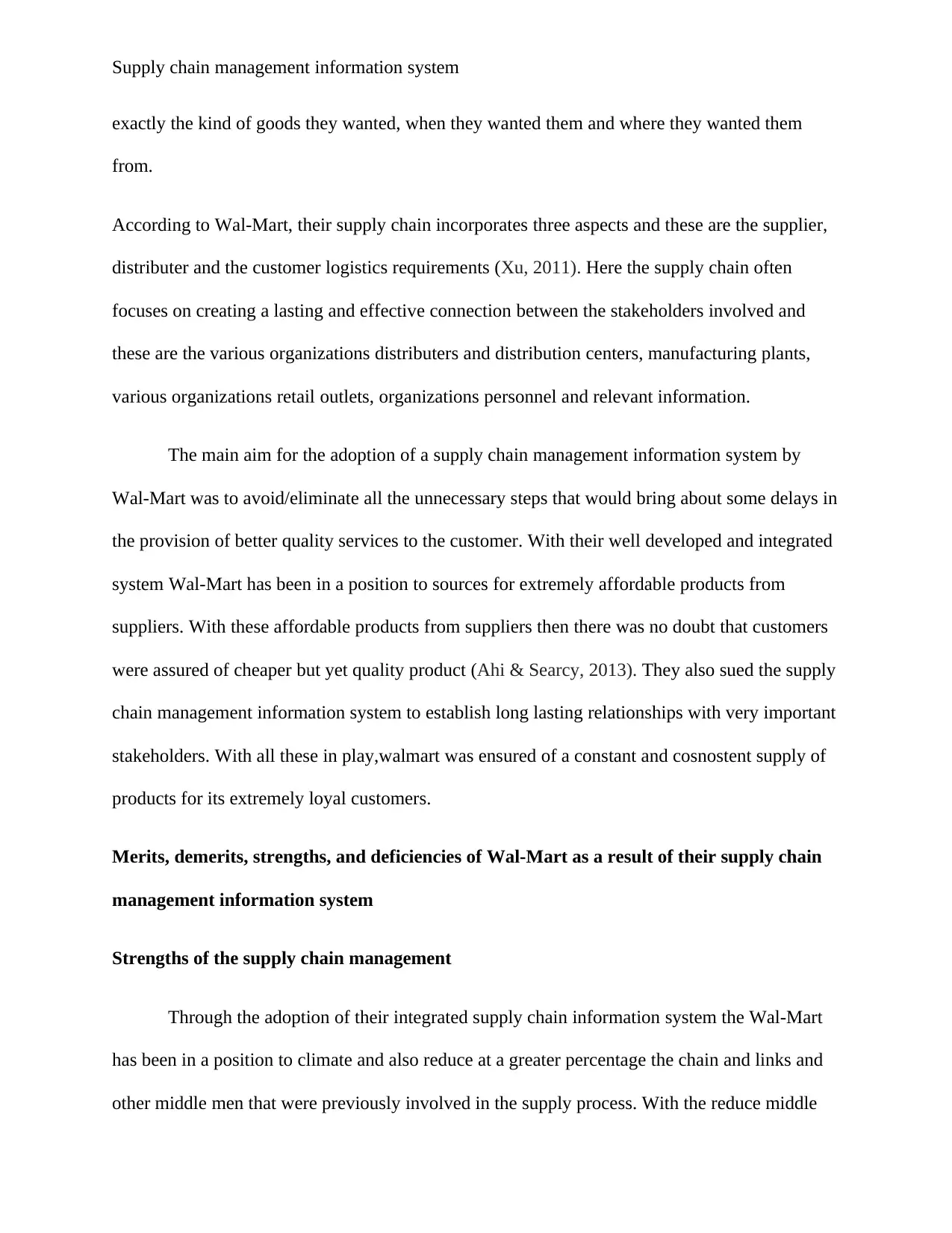
Supply chain management information system
exactly the kind of goods they wanted, when they wanted them and where they wanted them
from.
According to Wal-Mart, their supply chain incorporates three aspects and these are the supplier,
distributer and the customer logistics requirements (Xu, 2011). Here the supply chain often
focuses on creating a lasting and effective connection between the stakeholders involved and
these are the various organizations distributers and distribution centers, manufacturing plants,
various organizations retail outlets, organizations personnel and relevant information.
The main aim for the adoption of a supply chain management information system by
Wal-Mart was to avoid/eliminate all the unnecessary steps that would bring about some delays in
the provision of better quality services to the customer. With their well developed and integrated
system Wal-Mart has been in a position to sources for extremely affordable products from
suppliers. With these affordable products from suppliers then there was no doubt that customers
were assured of cheaper but yet quality product (Ahi & Searcy, 2013). They also sued the supply
chain management information system to establish long lasting relationships with very important
stakeholders. With all these in play,walmart was ensured of a constant and cosnostent supply of
products for its extremely loyal customers.
Merits, demerits, strengths, and deficiencies of Wal-Mart as a result of their supply chain
management information system
Strengths of the supply chain management
Through the adoption of their integrated supply chain information system the Wal-Mart
has been in a position to climate and also reduce at a greater percentage the chain and links and
other middle men that were previously involved in the supply process. With the reduce middle
exactly the kind of goods they wanted, when they wanted them and where they wanted them
from.
According to Wal-Mart, their supply chain incorporates three aspects and these are the supplier,
distributer and the customer logistics requirements (Xu, 2011). Here the supply chain often
focuses on creating a lasting and effective connection between the stakeholders involved and
these are the various organizations distributers and distribution centers, manufacturing plants,
various organizations retail outlets, organizations personnel and relevant information.
The main aim for the adoption of a supply chain management information system by
Wal-Mart was to avoid/eliminate all the unnecessary steps that would bring about some delays in
the provision of better quality services to the customer. With their well developed and integrated
system Wal-Mart has been in a position to sources for extremely affordable products from
suppliers. With these affordable products from suppliers then there was no doubt that customers
were assured of cheaper but yet quality product (Ahi & Searcy, 2013). They also sued the supply
chain management information system to establish long lasting relationships with very important
stakeholders. With all these in play,walmart was ensured of a constant and cosnostent supply of
products for its extremely loyal customers.
Merits, demerits, strengths, and deficiencies of Wal-Mart as a result of their supply chain
management information system
Strengths of the supply chain management
Through the adoption of their integrated supply chain information system the Wal-Mart
has been in a position to climate and also reduce at a greater percentage the chain and links and
other middle men that were previously involved in the supply process. With the reduce middle
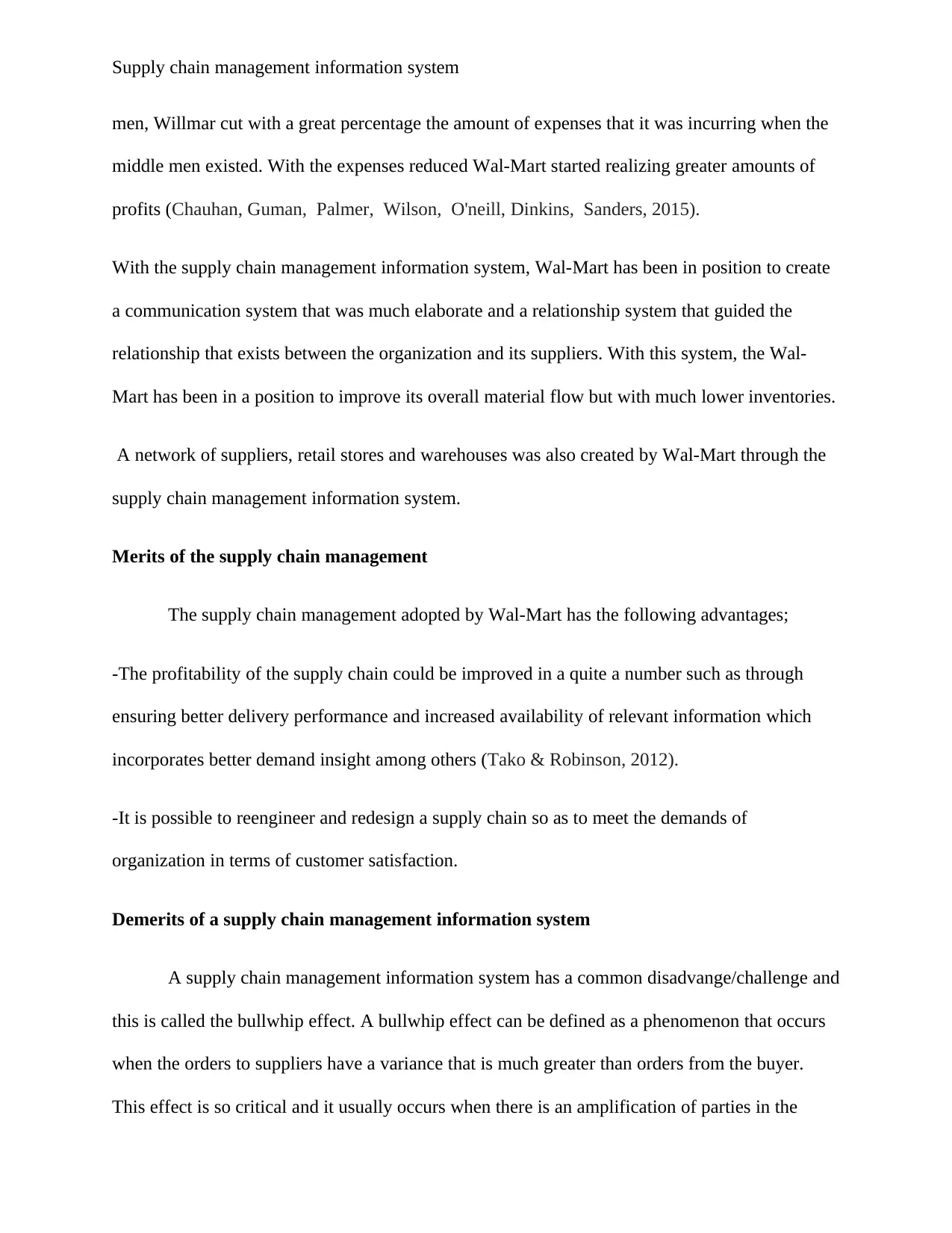
Supply chain management information system
men, Willmar cut with a great percentage the amount of expenses that it was incurring when the
middle men existed. With the expenses reduced Wal-Mart started realizing greater amounts of
profits (Chauhan, Guman, Palmer, Wilson, O'neill, Dinkins, Sanders, 2015).
With the supply chain management information system, Wal-Mart has been in position to create
a communication system that was much elaborate and a relationship system that guided the
relationship that exists between the organization and its suppliers. With this system, the Wal-
Mart has been in a position to improve its overall material flow but with much lower inventories.
A network of suppliers, retail stores and warehouses was also created by Wal-Mart through the
supply chain management information system.
Merits of the supply chain management
The supply chain management adopted by Wal-Mart has the following advantages;
-The profitability of the supply chain could be improved in a quite a number such as through
ensuring better delivery performance and increased availability of relevant information which
incorporates better demand insight among others (Tako & Robinson, 2012).
-It is possible to reengineer and redesign a supply chain so as to meet the demands of
organization in terms of customer satisfaction.
Demerits of a supply chain management information system
A supply chain management information system has a common disadvange/challenge and
this is called the bullwhip effect. A bullwhip effect can be defined as a phenomenon that occurs
when the orders to suppliers have a variance that is much greater than orders from the buyer.
This effect is so critical and it usually occurs when there is an amplification of parties in the
men, Willmar cut with a great percentage the amount of expenses that it was incurring when the
middle men existed. With the expenses reduced Wal-Mart started realizing greater amounts of
profits (Chauhan, Guman, Palmer, Wilson, O'neill, Dinkins, Sanders, 2015).
With the supply chain management information system, Wal-Mart has been in position to create
a communication system that was much elaborate and a relationship system that guided the
relationship that exists between the organization and its suppliers. With this system, the Wal-
Mart has been in a position to improve its overall material flow but with much lower inventories.
A network of suppliers, retail stores and warehouses was also created by Wal-Mart through the
supply chain management information system.
Merits of the supply chain management
The supply chain management adopted by Wal-Mart has the following advantages;
-The profitability of the supply chain could be improved in a quite a number such as through
ensuring better delivery performance and increased availability of relevant information which
incorporates better demand insight among others (Tako & Robinson, 2012).
-It is possible to reengineer and redesign a supply chain so as to meet the demands of
organization in terms of customer satisfaction.
Demerits of a supply chain management information system
A supply chain management information system has a common disadvange/challenge and
this is called the bullwhip effect. A bullwhip effect can be defined as a phenomenon that occurs
when the orders to suppliers have a variance that is much greater than orders from the buyer.
This effect is so critical and it usually occurs when there is an amplification of parties in the
You're viewing a preview
Unlock full access by subscribing today!
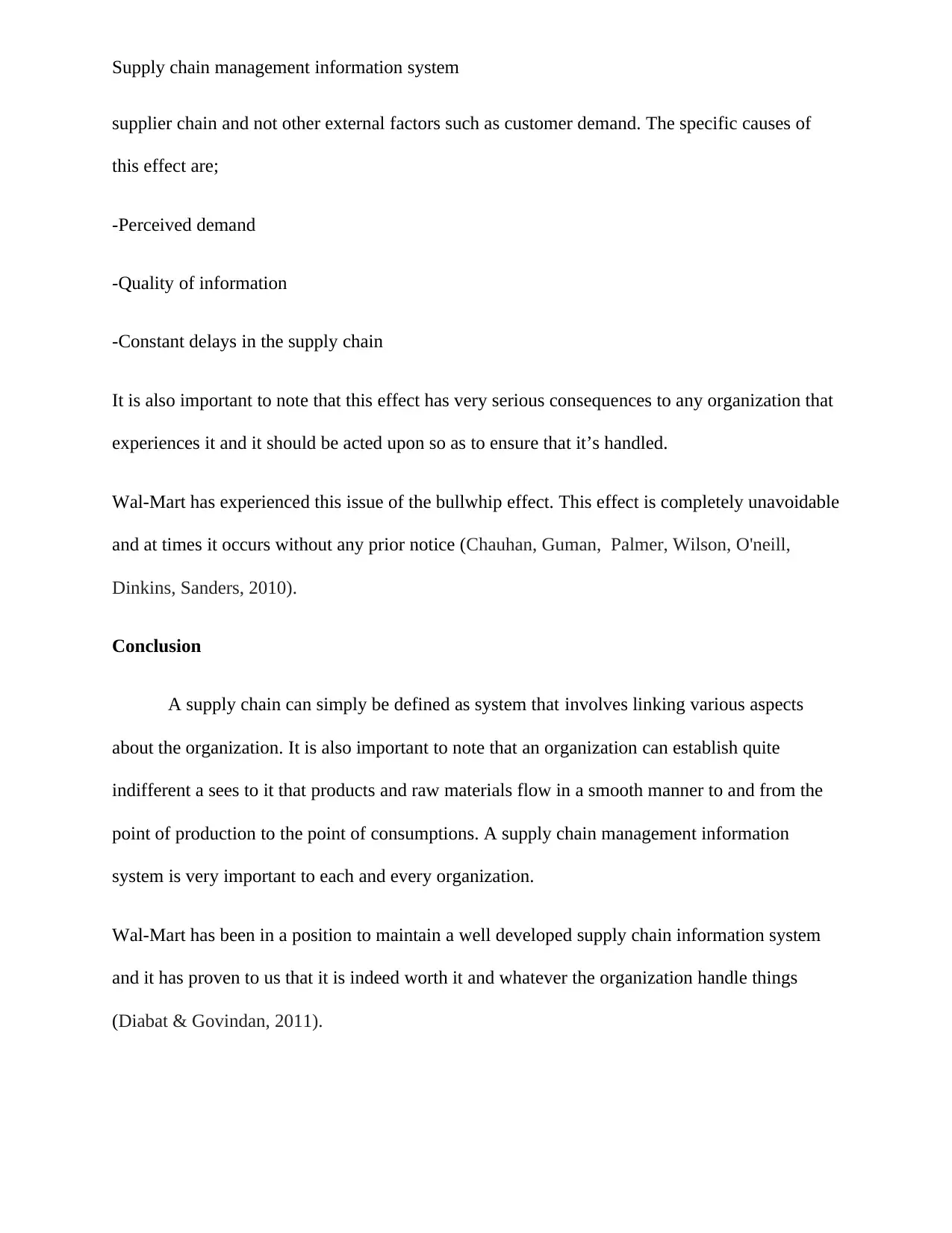
Supply chain management information system
supplier chain and not other external factors such as customer demand. The specific causes of
this effect are;
-Perceived demand
-Quality of information
-Constant delays in the supply chain
It is also important to note that this effect has very serious consequences to any organization that
experiences it and it should be acted upon so as to ensure that it’s handled.
Wal-Mart has experienced this issue of the bullwhip effect. This effect is completely unavoidable
and at times it occurs without any prior notice (Chauhan, Guman, Palmer, Wilson, O'neill,
Dinkins, Sanders, 2010).
Conclusion
A supply chain can simply be defined as system that involves linking various aspects
about the organization. It is also important to note that an organization can establish quite
indifferent a sees to it that products and raw materials flow in a smooth manner to and from the
point of production to the point of consumptions. A supply chain management information
system is very important to each and every organization.
Wal-Mart has been in a position to maintain a well developed supply chain information system
and it has proven to us that it is indeed worth it and whatever the organization handle things
(Diabat & Govindan, 2011).
supplier chain and not other external factors such as customer demand. The specific causes of
this effect are;
-Perceived demand
-Quality of information
-Constant delays in the supply chain
It is also important to note that this effect has very serious consequences to any organization that
experiences it and it should be acted upon so as to ensure that it’s handled.
Wal-Mart has experienced this issue of the bullwhip effect. This effect is completely unavoidable
and at times it occurs without any prior notice (Chauhan, Guman, Palmer, Wilson, O'neill,
Dinkins, Sanders, 2010).
Conclusion
A supply chain can simply be defined as system that involves linking various aspects
about the organization. It is also important to note that an organization can establish quite
indifferent a sees to it that products and raw materials flow in a smooth manner to and from the
point of production to the point of consumptions. A supply chain management information
system is very important to each and every organization.
Wal-Mart has been in a position to maintain a well developed supply chain information system
and it has proven to us that it is indeed worth it and whatever the organization handle things
(Diabat & Govindan, 2011).
Paraphrase This Document
Need a fresh take? Get an instant paraphrase of this document with our AI Paraphraser
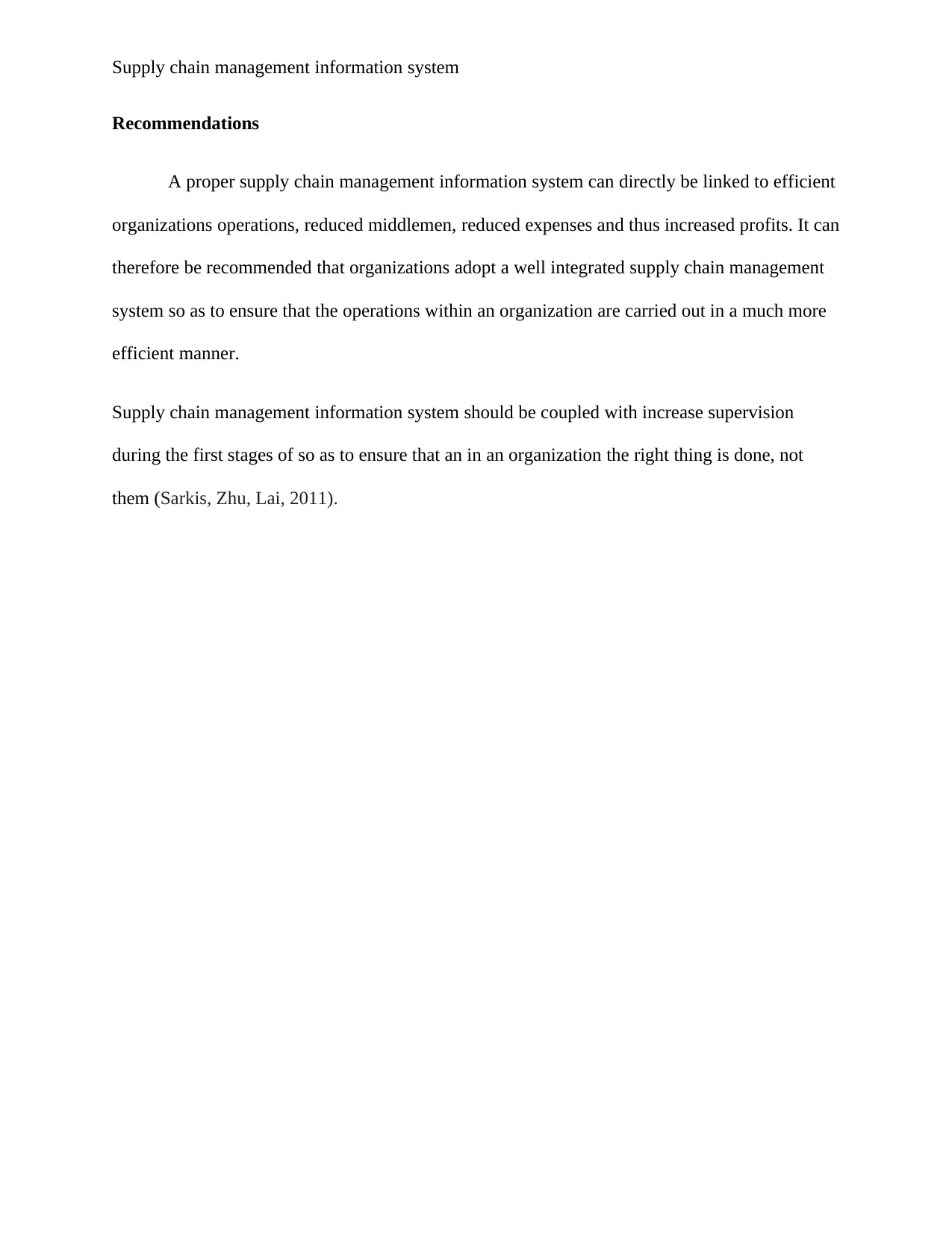
Supply chain management information system
Recommendations
A proper supply chain management information system can directly be linked to efficient
organizations operations, reduced middlemen, reduced expenses and thus increased profits. It can
therefore be recommended that organizations adopt a well integrated supply chain management
system so as to ensure that the operations within an organization are carried out in a much more
efficient manner.
Supply chain management information system should be coupled with increase supervision
during the first stages of so as to ensure that an in an organization the right thing is done, not
them (Sarkis, Zhu, Lai, 2011).
Recommendations
A proper supply chain management information system can directly be linked to efficient
organizations operations, reduced middlemen, reduced expenses and thus increased profits. It can
therefore be recommended that organizations adopt a well integrated supply chain management
system so as to ensure that the operations within an organization are carried out in a much more
efficient manner.
Supply chain management information system should be coupled with increase supervision
during the first stages of so as to ensure that an in an organization the right thing is done, not
them (Sarkis, Zhu, Lai, 2011).
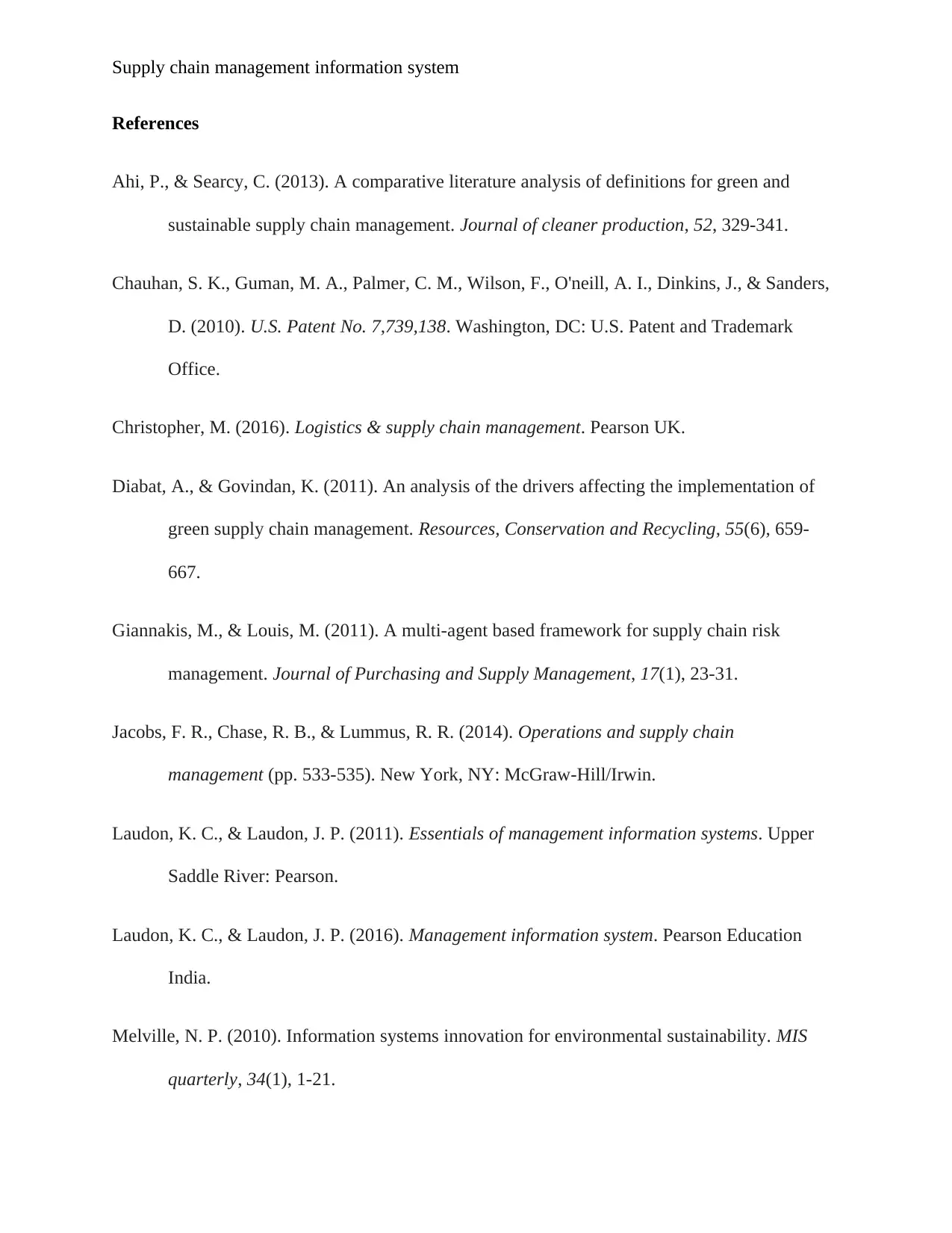
Supply chain management information system
References
Ahi, P., & Searcy, C. (2013). A comparative literature analysis of definitions for green and
sustainable supply chain management. Journal of cleaner production, 52, 329-341.
Chauhan, S. K., Guman, M. A., Palmer, C. M., Wilson, F., O'neill, A. I., Dinkins, J., & Sanders,
D. (2010). U.S. Patent No. 7,739,138. Washington, DC: U.S. Patent and Trademark
Office.
Christopher, M. (2016). Logistics & supply chain management. Pearson UK.
Diabat, A., & Govindan, K. (2011). An analysis of the drivers affecting the implementation of
green supply chain management. Resources, Conservation and Recycling, 55(6), 659-
667.
Giannakis, M., & Louis, M. (2011). A multi-agent based framework for supply chain risk
management. Journal of Purchasing and Supply Management, 17(1), 23-31.
Jacobs, F. R., Chase, R. B., & Lummus, R. R. (2014). Operations and supply chain
management (pp. 533-535). New York, NY: McGraw-Hill/Irwin.
Laudon, K. C., & Laudon, J. P. (2011). Essentials of management information systems. Upper
Saddle River: Pearson.
Laudon, K. C., & Laudon, J. P. (2016). Management information system. Pearson Education
India.
Melville, N. P. (2010). Information systems innovation for environmental sustainability. MIS
quarterly, 34(1), 1-21.
References
Ahi, P., & Searcy, C. (2013). A comparative literature analysis of definitions for green and
sustainable supply chain management. Journal of cleaner production, 52, 329-341.
Chauhan, S. K., Guman, M. A., Palmer, C. M., Wilson, F., O'neill, A. I., Dinkins, J., & Sanders,
D. (2010). U.S. Patent No. 7,739,138. Washington, DC: U.S. Patent and Trademark
Office.
Christopher, M. (2016). Logistics & supply chain management. Pearson UK.
Diabat, A., & Govindan, K. (2011). An analysis of the drivers affecting the implementation of
green supply chain management. Resources, Conservation and Recycling, 55(6), 659-
667.
Giannakis, M., & Louis, M. (2011). A multi-agent based framework for supply chain risk
management. Journal of Purchasing and Supply Management, 17(1), 23-31.
Jacobs, F. R., Chase, R. B., & Lummus, R. R. (2014). Operations and supply chain
management (pp. 533-535). New York, NY: McGraw-Hill/Irwin.
Laudon, K. C., & Laudon, J. P. (2011). Essentials of management information systems. Upper
Saddle River: Pearson.
Laudon, K. C., & Laudon, J. P. (2016). Management information system. Pearson Education
India.
Melville, N. P. (2010). Information systems innovation for environmental sustainability. MIS
quarterly, 34(1), 1-21.
You're viewing a preview
Unlock full access by subscribing today!
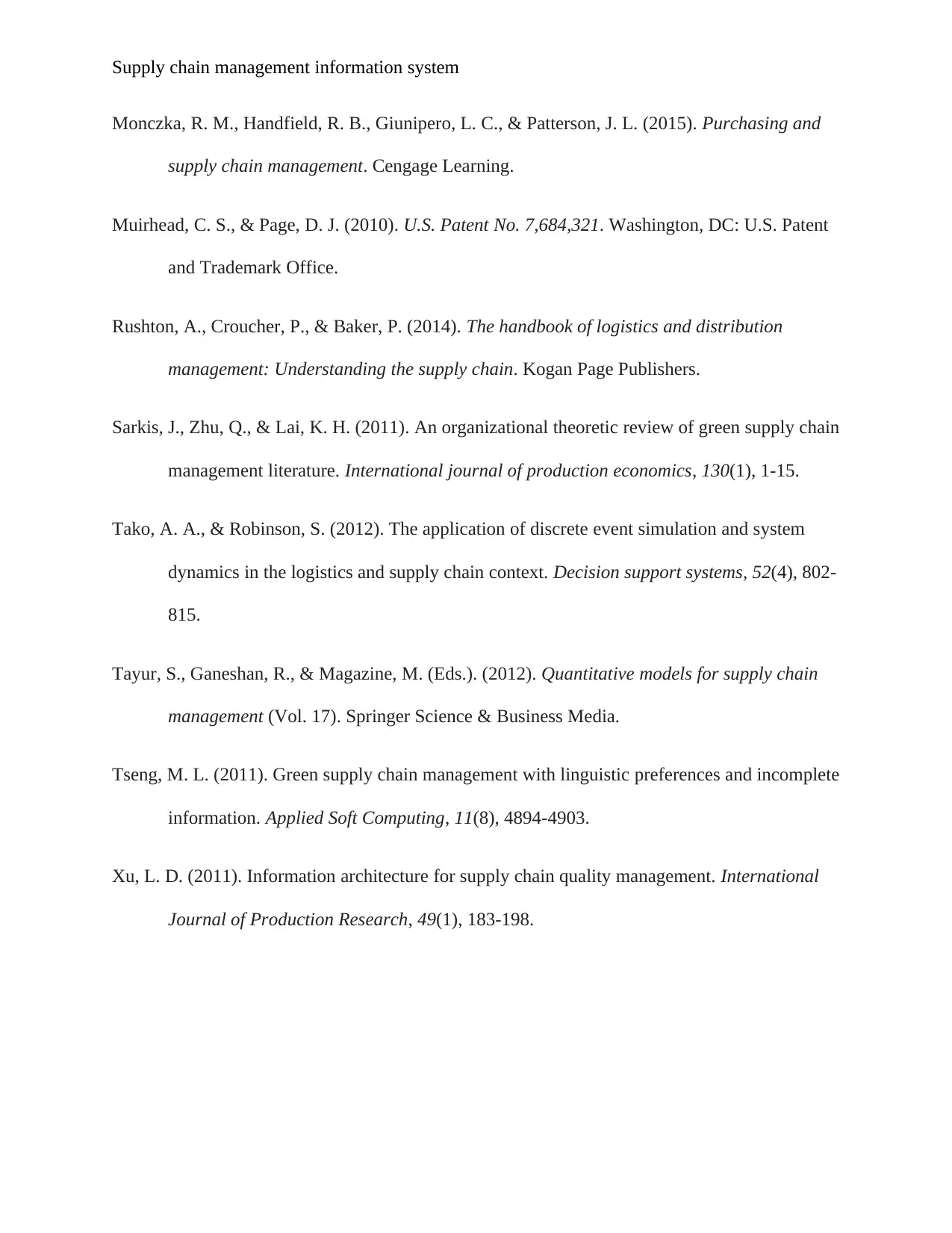
Supply chain management information system
Monczka, R. M., Handfield, R. B., Giunipero, L. C., & Patterson, J. L. (2015). Purchasing and
supply chain management. Cengage Learning.
Muirhead, C. S., & Page, D. J. (2010). U.S. Patent No. 7,684,321. Washington, DC: U.S. Patent
and Trademark Office.
Rushton, A., Croucher, P., & Baker, P. (2014). The handbook of logistics and distribution
management: Understanding the supply chain. Kogan Page Publishers.
Sarkis, J., Zhu, Q., & Lai, K. H. (2011). An organizational theoretic review of green supply chain
management literature. International journal of production economics, 130(1), 1-15.
Tako, A. A., & Robinson, S. (2012). The application of discrete event simulation and system
dynamics in the logistics and supply chain context. Decision support systems, 52(4), 802-
815.
Tayur, S., Ganeshan, R., & Magazine, M. (Eds.). (2012). Quantitative models for supply chain
management (Vol. 17). Springer Science & Business Media.
Tseng, M. L. (2011). Green supply chain management with linguistic preferences and incomplete
information. Applied Soft Computing, 11(8), 4894-4903.
Xu, L. D. (2011). Information architecture for supply chain quality management. International
Journal of Production Research, 49(1), 183-198.
Monczka, R. M., Handfield, R. B., Giunipero, L. C., & Patterson, J. L. (2015). Purchasing and
supply chain management. Cengage Learning.
Muirhead, C. S., & Page, D. J. (2010). U.S. Patent No. 7,684,321. Washington, DC: U.S. Patent
and Trademark Office.
Rushton, A., Croucher, P., & Baker, P. (2014). The handbook of logistics and distribution
management: Understanding the supply chain. Kogan Page Publishers.
Sarkis, J., Zhu, Q., & Lai, K. H. (2011). An organizational theoretic review of green supply chain
management literature. International journal of production economics, 130(1), 1-15.
Tako, A. A., & Robinson, S. (2012). The application of discrete event simulation and system
dynamics in the logistics and supply chain context. Decision support systems, 52(4), 802-
815.
Tayur, S., Ganeshan, R., & Magazine, M. (Eds.). (2012). Quantitative models for supply chain
management (Vol. 17). Springer Science & Business Media.
Tseng, M. L. (2011). Green supply chain management with linguistic preferences and incomplete
information. Applied Soft Computing, 11(8), 4894-4903.
Xu, L. D. (2011). Information architecture for supply chain quality management. International
Journal of Production Research, 49(1), 183-198.
1 out of 13
Related Documents
Your All-in-One AI-Powered Toolkit for Academic Success.
+13062052269
info@desklib.com
Available 24*7 on WhatsApp / Email
![[object Object]](/_next/static/media/star-bottom.7253800d.svg)
Unlock your academic potential
© 2024 | Zucol Services PVT LTD | All rights reserved.





